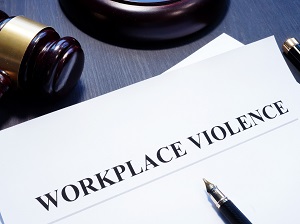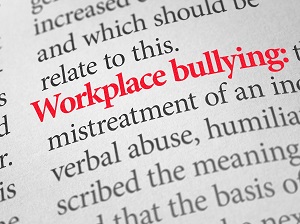Every year, approximately 2 million people in the US are victims of workplace violence resulting in nearly 1,000 deaths occurring annually.

Workplace violence covers a broad range of unacceptable behavior from threats and verbal abuse to physical assaults and homicide and refers to any act in which a worker is abused, threated, intimidated, or assaulted at their place of employment.
Workplace violence, or threat of violence, may involve employees, clients, customers, or visitors and can occur at or outside the workplace or job site.
While there are currently no specific OSHA standards that pertain to workplace violence, the General Duty Clause could apply and violence or threats of violence in all forms are unacceptable workplace behavior.
OSHA General Duty Clause 5(a)(1) Each employer shall furnish to each of his employees employment and a place of employment which are free from recognized hazards that are causing or are likely to cause death or serious physical harm to his employees.
Employees have a responsibility to treat everyone at work with dignity and respect and have the right to expect the same level of behavior from their co-workers.

According to NIOSH, there are four main types of workplace violence:
Type 1 – Criminal Intent. Violence that isn’t necessarily related specifically to the workers or the business, like robbery, shoplifting, trespassing, and acts of terrorism.
Type 2 – Customer/Client. Has a current or previous relationship with the business as a customer, client, patient, or student and turns to violence to express frustration or dissatisfaction.
Type 3 – Worker on Worker. A disgruntled employee or former employee who becomes violent or threatens other employees.
Type 4 – Personal Relationship. The perpetrator seeks out their intended victim at their place of work.
Examples of workplace violence among co-workers include:
- verbal abuse, anger-related incidents
- sabotage, vandalism, property damage
- intimidation, threats (direct or indirect)
- physically aggressive acts
- pushing, physical assault
- psychological trauma
- harassment, stalking
- use of a weapon
- arson, rape, murder

While it might not be possible to accurately predict all episodes of workplace violence, it’s helpful if employees know the indicators and behaviors that might signal an increased risk for violence.
Particularly take note if there is a drastic change in behavior, the frequency and intensity of behavior becomes disruptive, or the person is exhibiting many of the warning behaviors (rather than just one or a few). Warning signs may include:
- inability to manage anger including scowling, sneering, outbursts of swearing or slamming doors
- overreaction to company policies or persistent complaining about unfair treatment
- aggressive behavior, exaggerated or violent gestures, clenched jaws or fists
- unexplained absenteeism, change in behavior or decline in job performance
- holds grudges and verbalizes wish that something bad happen to another person
- paranoia, increased mood swings, or erratic emotional responses
- depression, withdrawal or suicidal comments
- repeated direct or veiled threats to harm others
- sudden and unpredictable change in energy level
- persistent, unwanted romantic interest in a co-worker
- consistently and/or aggressively violating personal space
- obsession with weapons
- excessive use of alcohol or drugs
- poor personal hygiene or signs of extreme fatigue

These situations may cause issues with identifying potential future workplace violence.
- Employees or management may ignore warning signs of violent tendencies because they believe that it is none of their business, the indicators don’t seem to add up to anything worth reporting, or the behavior is excused as being typically characteristic for that particular person.
- Workers may react on fear and incorrectly profile someone as a potentially violent person based on religion or appearance, when there were no actual warning signs observed.
- Employees may not know the procedure to follow or where to go to get help in making determinations regarding real and potential risks.
If any employee is concerned about a co-worker, or any other person, who shows some or many of the warning signs, they should take action by reporting concerns to a supervisor or to the HR department.

Workplace bullying is also a health and safety concern for any organization because of the negative impacts that can occur as a result of a hostile work environment. Employees that are victims of or witnesses to workplace bullying can suffer emotional, mental and physical distress which leads to an increase in stress, absenteeism and risk of incidents.
Workplace bullying is repeated, and unwanted aggressive behavior and persistent acts of disrespect directed toward an individual.
A workplace bully often has real or assumed authority over their target which can be position or rank in the company, but it can also be a difference in seniority, job knowledge, expertise, perceived power, body size or strength. A bully may even base their power on gossip, lies or secrets.
Bullying exists in workplace cultures that tolerate disrespectful behavior. Employees have a responsibility to treat everyone at work with dignity and respect and have the right to expect the same level of behavior from their co-workers.

There may be disagreements and annoyances experienced at work and not every difference of opinion is considered bullying behavior. Consider that someone may be having a bad day when they make a rude comment, a co-worker doesn’t have a personality-type that you prefer, or you aren’t in the mood to take constructive criticism from a supervisor. Finding ways to work well together is not the same as dealing with a workplace bully.
Workplace bullying is often repetitive, negative behavior with an intent to consistently dominate another person. Workplace bullying tactics include:
- insults and threats
- intimidation
- mockery, condescension, or humiliation
- gossip and rumors
- sabotage or wrongful blame
- shaming, berating, belittling
- invasion of personal space
- tripping or pushing
- withholding key information
- stealing credit for ideas
- interrupting, preventing others from speaking
- scoffs or makes negative comments when others share ideas

Ideally, there will be a zero-tolerance policy towards workplace violence and bullying that covers all workers, contractors, visitors, and anyone who may come in contact with company personnel.
It is critical that all workers know where to find and understand their organization’s health and safety program, including any workplace violence prevention and reporting policies.
All claims of potential or actual workplace violence or bullying should be confidential, taken seriously and investigated promptly.

.jpeg)

.jpg)
